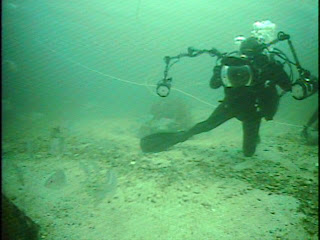After we loaded on the heap of stuff, we set out for one of our artificial reef study sites. David and Jen explained that they wanted to get a realistic view of our ROV research so they wanted to shoot specifically on our study reefs. Jen was very inquisitive on artificial reefs and how/why they’re deployed, their function, and their controversy in the Gulf of Mexico. She took some notes down and mentioned to us that we’d be giving more formal interviews a little later. After she asked us all of her questions to get a feel for what we do and our research, I had some questions of my own about her work and travels. Her and David jet set around the world on numerous assignments, so she had plenty of amusing stories to tell.
When we reached our shoot location, there began a frenzy of activity to get things ready for both the ROV team and the dive team. David sat down with us to go over what he hoped to capture down on the bottom and what hand signals he may give to me through the ROV camera for direction. He gave me approximately 20 signals…I think I actually remembered 3.
This signal means "this gear is heavy, and I could use a lower back massage."
David and Jen geared up and performed a standard backwards flip off the boat. I won’t go into too many details, but the first dive was unsuccessful due to a heinous mixture of water current, entanglement, sea sickness, poor line placement, and bad visibility. The two made it back on deck for a rest and a new game plan. We readjusted the lines, changed tanks, and put them back in the water. Meanwhile, the ROV had been sitting on the bottom twiddling its thumbs for an hour or so.They touched down on the reef site at about 100 ft, and I followed them around with the ROV like an eager little puppy. Once they readied the cameras and lighting, David signaled me to fly broadside the reef to get some good shots.
Yes! Yes! NO! NO!
After a few minutes of posing and shooting, the ROV ran into some trouble. I had gotten a little too close to some fishing line attached to the reef. The fishing line got sucked into one of my propellers, disabling some of the controls. This resulted in very erratic movements, many of which were in the wrong direction. I was not only scaring all of the fish, but also annoying the crap out of David. David later told me that he compared the ROV to a loud, irritating mosquito that would quickly zip around randomly. He called the fiasco, “ROV behaving badly”.We then had a little talk. An "understanding", if you will.
Jen had to grab a hold of the ROV and put it into the shot by hand a few times. After 30-40 minutes of bottom time, they made it back up to the boat. I was worried that David would pop up to say that he left the lens cap on. They seemed happy about the shoot, which was a good thing because they didn’t have any tanks left.
Jen also took some shots of us on deck with the ROV equipment. She mentioned that these pictures would most likely make it on to their ROV blog via the National Geographic website. When I find the link, I'll let you know.
David and Jen thought the shots looked good, but they may try to come back in a week or two to “sex it up”. I think they want to shoot the ROV on some other reef sites off of Florida. We’re definitely up for it. They told us that the article would be in National Geographic in the spring of 2010.
By far the coolest thing I've ever done.











I'm impressed. - Aunt T.
ReplyDeleteYou mean the coolest thing you've ever done besides marry the most amazing woman in the universe.
ReplyDeleteummm, er...yes! of course, darling.
ReplyDeleteNice save.
ReplyDeleteNOT.
LOL - Aunt T.
Okay, so I read your article to Trey, and he wants to know if he can do that!! I just wanted to let you know that I think you are amazing! Of course, without Katie you would just be so-so, but because you have such great taste, your status has improved! Can't wait to see and hear more. Good Luck!! - Amy
ReplyDelete